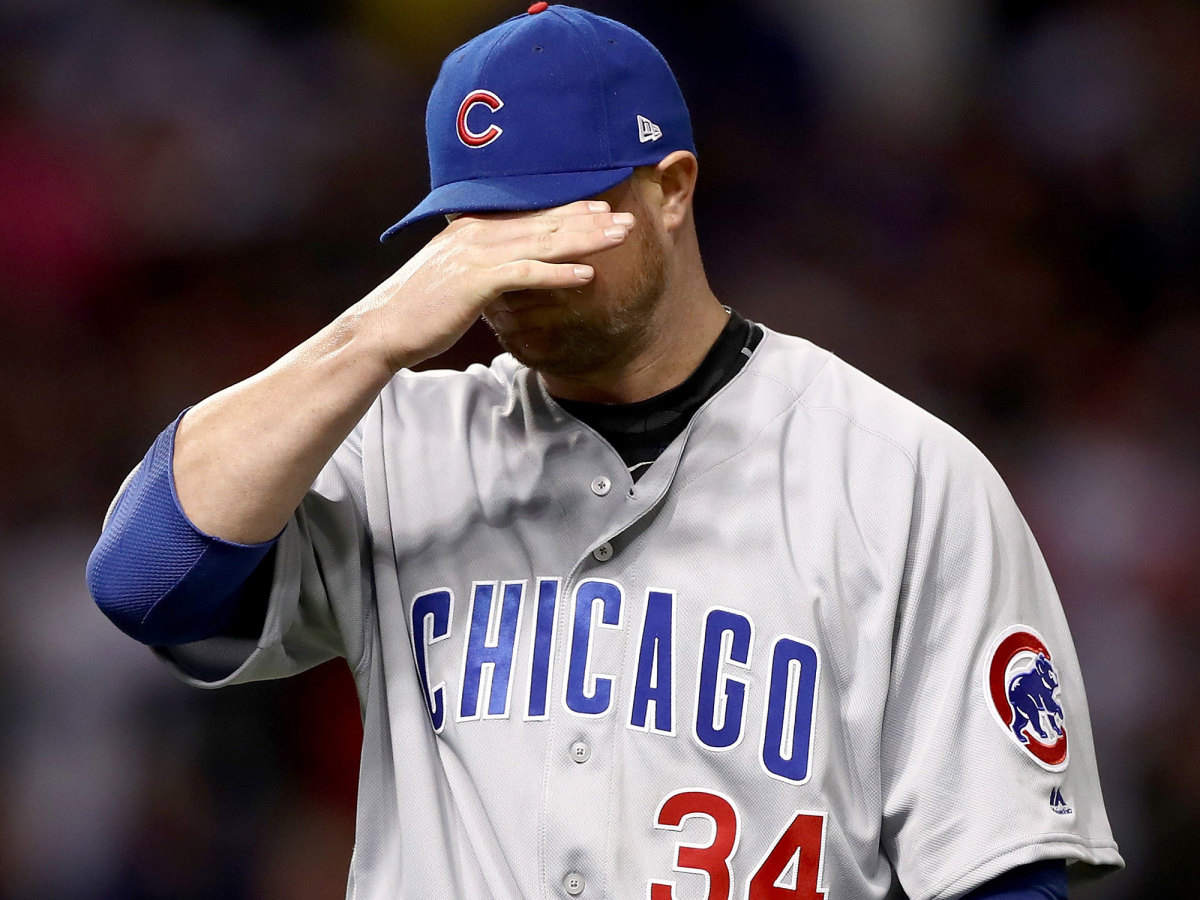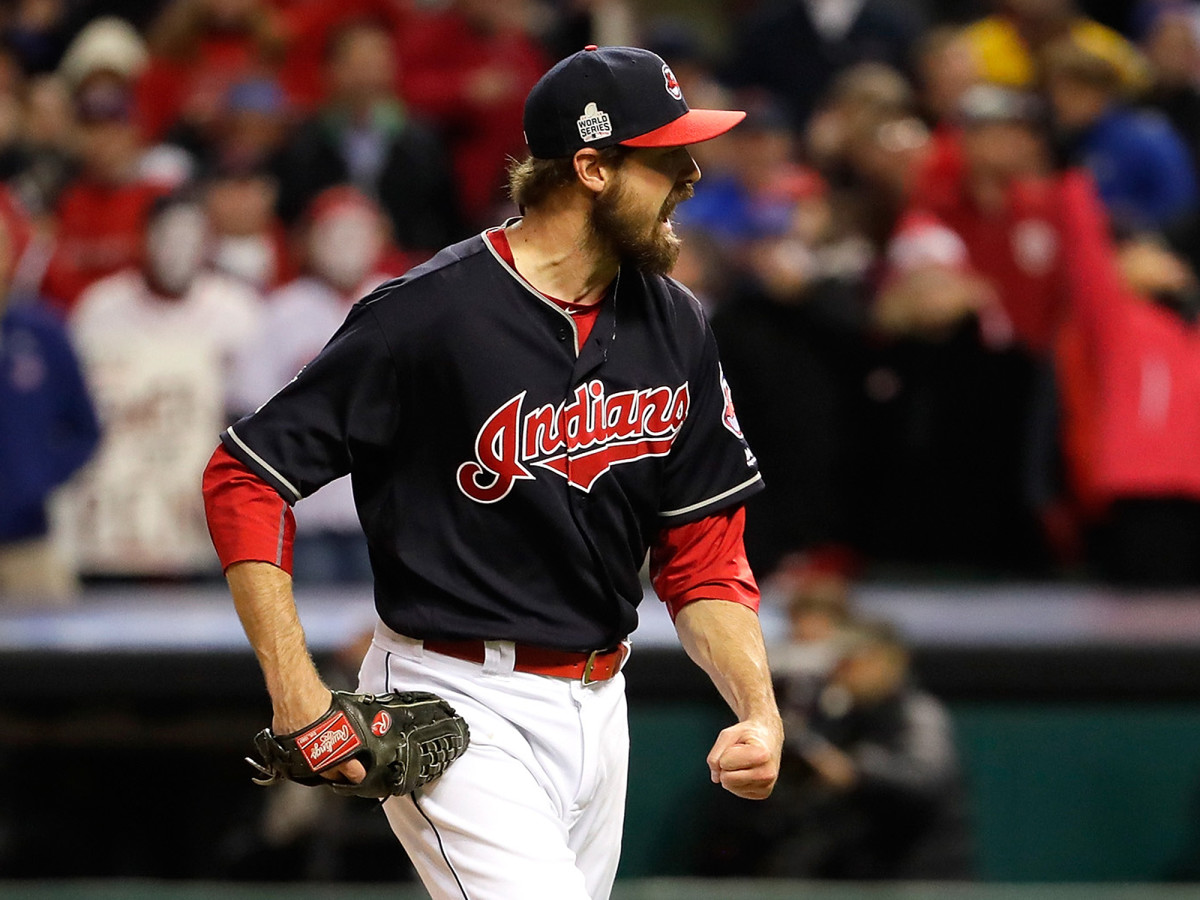Three Strikes: Kluber, Perez lead Indians over Cubs in World Series opener

In the battle of the two teams with the longest championship droughts, round one went to the Indians. Corey Kluber shut the Cubs out for six innings on Tuesday night, making history in the process, while Cleveland’s offense took advantage of Jon Lester’s well-known throwing tics and light-hitting catcher Roberto Perez became the first catcher in 30 years to club two homers in a World Series game in the Indians' 6–0 Game 1 win.
The Indians are now three wins away from their first championship since 1948. The start time for Game 2, pitting Jake Arrieta and Trevor Bauer, has been moved up by an hour, to 7 p.m. ET/6 CT, due to expected rain later in the evening. Beyond that, here are three thoughts about the game.
Kluber dominates
Corey Kluber had already dominated during his previous postseason outings, holding the Red Sox and Blue Jays to a combined two runs and 13 hits in 18 1/3 innings over three starts and striking out 20. On Tuesday night, however, the 30-year-old righty took it to the next level, making history in the process
In the first inning, Kluber struck out both Dexter Fowler and Kris Bryant looking, the latter on a fastball on the outside corner that he thought was ball four. In the second, after allowing a leadoff double to Ben Zobrist, he recovered to strike out Kyle Schwarber (making his first MLB plate appearance since April 7) swinging at a sinker, then got both Javier Baez and Chris Coghlan on called strikes. In the third, he worked around a one-out David Ross single to strike out the side again, catching Addison Russell looking at a curveball, getting Fowler to swing through a sinker and getting Bryant to whiff at a curve as well.
An MLB scout on the strengths and weaknesses of the Cubs and the Indians
With that, Kluber became the first pitcher to strike out eight in the first three innings of a World Series game. Just two of those eight strikeouts were swinging, and for the most part, all of the called strikes Kluber got were to his glove side—inside to a lefthanded batter, outside to a righty. In the Fox booth, John Smoltz pointed to Kluber’s first pitch of the fifth inning, a called strike to Coghlan, as the first one on Kluber’s arm side. He punched out the lefty-swinging Coghlan on an inside sinker, right where he’d been pouring pitches all night.
Kluber wound up working six-plus innings, striking out nine and walking none and allowing just four hits; a two-out double by Schwarber in the fourth and then a leadoff single by Zobrist in the seventh that knocked him out of the game were the others. He threw 88 pitches, and while he certainly could have gone deeper, manager Terry Francona would clearly like to bring him back on three days of rest for Games 4 and 7 if necessary—something no pitcher has done since Curt Schilling in 2001. When you’ve got Andrew Miller in the bullpen, it’s a lot easier to entertain such thoughts.
Via Brooks Baseball, Kluber got 10 swings and misses—five via his curve, three via his slider and two via his sinker, which also froze four of his strikeout victims. Via the Baseball-Reference Play Index, his nine strikeouts set an Indians World Series record, surpassing the previous record of seven, shared by Orel Hershiser in Game 1 of the 1995 World Series against the Braves and Jaret Wright in Game 7 of the ‘97 Series against the Marlins. The strikeouts were the most by a pitcher in his World Series debut and the most in a World Series opener since the Phillies’ Cliff Lee whiffed 10 in 2009.
• Timeline: An in-depth look at the Cubs’ history and title drought

Lester takes his lumps
Lester came in having strung together three exceptional postseason starts himself, allowing just two runs in 21 innings against the Giants and Dodgers. But for all of his dominance, much of the talk prior to the game was how much better-equipped the Indians were to take advantage of the 32-year-old lefty’s reluctance to throw over to first base or field infield grounders than the Cubs’ previous opponents. Indeed, the first inning put Lester’s issues on display, and by the time the dust settled, the Indians matched the Giants and Dodgers’ total of runs against him in three postseason innings.
With two outs in the first, Francisco Lindor singled, then took advantage of Lester’s unwillingness to throw over to first base by stealing second. Lester, perhaps unnerved, then loaded the bases by issuing a pair of five-pitch walks to Mike Napoli and Carlos Santana. Jose Ramirez followed with a swinging bunt into no-man’s land on the third base side of the mound. Lester went nowhere near it, and by the time Bryant arrived, it was too late to make a play; Lindor scampered home with the game’s first run. Napoli followed him home when Lester hit Brandon Guyer—who was plunked an MLB-high 31 times this year—on the right leg with a cutter. The Cubs finally escaped when David Ross crashed into the backstop to catch Lonnie Chisenhall’s foul ball, but by then, the Indians led 2–0 and Lester had thrown 26 pitches.
World Series: Running bases, returning sluggers and more keys to Cubs-Indians
Lester retired Cleveland on 13 pitches in the second, but Lindor led off the third with a single, and after Napoli struck out, he broke for second while Lester was watching him—then stopped and retreated without drawing a throw. A couple of pitches later, Lindor did break for second, but Ross made a great throw and Baez appeared to get the tag down. The call on the field was out, and the Indians didn’t challenge.
But Lester couldn’t escape immediately. He walked Santana on five pitches, then yielded a single to Ramirez, after which Santana came up limping and had to be tended to by the Indians' trainers. Santana didn’t advance on a pitch that got away from Ross, and Lester recovered to strike Guyer out looking at a fastball on the outside corner to keep the score 2–0, but it ran his pitch count to 54 through three innings.
Lester got dinged in the fourth when Roberto Perez—who hit just .183/.285/.294 with three homers this year—led off the frame by connecting with a high 92-mph fastball for a solo homer to leftfield and a 3–0 lead. Via Statcast, the shot left the bat with a 113-mph exit velocity—enough oomph to send it 391 feet despite just a 19-degree launch angle.
• Breaking down Cubs vs. Indians, position by position
Lester departed with two outs in the sixth, having yielded a leadoff double. Pedro Strop came in and struck out Perez looking at a slider to keep the deficit at three runs.
In all, Lester’s outing was his shortest postseason turn since he went 5 2/3 innings in Game 3 of the 2008 ALCS against the Rays; he’d made 13 starts since then, carving himself a spot as one of the era’s top postseason pitchers. He yielded six hits and three walks and struck out seven, netting 12 swings and misses from among his 93 pitches, seven of them with his four-seam fastball. Without that first inning, it would have ranked as another impressive start, but with it, the Cubs are now in a rare hole.

Miller Time and Perez Power
After Zobrist’s single to start the seventh, Francona called upon Miller, who in the first two rounds of the postseason tossed 11 2/3 scoreless innings, striking out 21, walking just two and allowing a mere five hits. Things did not go as smoothly this time around, even with Miller coming in to face the lefty-swinging Schwarber, who has hit just .143/.213/.268 with 27 strikeouts in 61 plate appearances against southpaws in his big-league career. With Miller working him away, Schwarber managed to work a six-pitch walk, and Baez followed with a single to load the bases with nobody out. It looked like somebody might finally break through against the towering 31-year-old lefty.
The next hitter, Willson Contreras, bluffed a bunt, then hit a shallow fly ball to centerfield that Rajai Davis ran down. Conscious of the possibility of Zobrist tagging up, he threw home on one hop, but in doing so, Davis missed Schwarber having strayed off second, which would have made for an easy double play. No matter: Miller struck Russell out on three pitches, and after falling behind Ross 3–1, came back with a called strike on slider, then a check-swing strike on an absolutely hellacious sweeping slider that would have been a run-scoring ball four.
Andrew Miller: Inside his journey to a new type of October dominance
The Cubs gave Miller a battle in the eighth as well, with Bryant drawing a one-out walk and Zobrist hitting a two-out single, his third hit of the night, which matched his total in each of the previous two series. Miller escaped by striking out Schwarber on a slider, the big slugger nearly corkscrewing himself into the ground on his swing. In all, Miller threw 46 pitches—almost certainly ruling him out for Game 2—and struck out three, keeping his string of zeroes intact.
Cody Allen pitched a scoreless ninth, striking out three, but before he did, the Indians extended their lead in the bottom of the eighth against Justin Grimm and Hector Rondon. Grimm got the first two outs, then walked Guyer, yielded a single to Chisenhall and departed. Rondon hung a 2–2 slider to Perez, who hit a towering three-run homer to left-center.
Here's Hammy's call of @robperez2015's second blast, a three-run shot that put the game away! #RallyTogether https://t.co/3U2tgE2XiX
— Cleveland Guardians (@CleGuardians) October 26, 2016
That was Perez’s third postseason homer; his first came in the Division Series opener, the first of three third-inning shots off of Boston’s Rick Porcello. With his blast off Rondon, he became the franchise’s first player with a multi-homer game in the World Series and the first to go yard twice in a postseason game since Jim Thome in Game 5 of the 1999 Division Series against the Red Sox.
• Godwinks and hallelujah: Cubs reward faithful fans with long-awaited pennant
What’s more, Perez joined some particularly impressive company as the fifth catcher to homer twice in a World Series game. Three of the previous four are Hall of Famers: the Yankees’ Yogi Berra (Game 7 in 1956 against the Dodgers); the Reds’ Johnny Bench (Game 4 in 1976 against the Yankees); and the Mets’ Gary Carter (Game 4 in 1986 against the Red Sox). The other is stathead favorite Gene Tenace of the 1972 A’s against the Reds. The last catcher to have a multi-homer World Series game was Carter, who hit two for the Mets in Game 4 of the 1986 World Series against the Red Sox.
